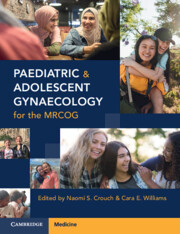Book contents
- Paediatric and Adolescent Gynaecology for the MRCOG
- Paediatric and Adolescent Gynaecology for the MRCOG
- Copyright page
- Contents
- Contributors
- Introduction
- Chapter 1 Embryological Development of the Internal and External Female Genitalia
- Chapter 2 Gynaecological History and Examination in Children and Adolescents
- Chapter 3 Normal and Precocious Puberty
- Chapter 4 Common Prepubertal Problems in Paediatric Gynaecology
- Chapter 5 Adolescent Menstrual Dysfunction
- Chapter 6 Polycystic Ovary Syndrome in Adolescence
- Chapter 7 Müllerian Duct Anomalies
- Chapter 8 Primary Amenorrhoea and Delayed Puberty
- Chapter 9 Rokitansky Syndrome
- Chapter 10 Turner Syndrome
- Chapter 11 Differences in Sex Development
- Chapter 12 Premature Ovarian Insufficiency
- Chapter 13 Gynaecological Laparoscopy in Adolescents
- Chapter 14 Psychology in Paediatric and Adolescent Gynaecology
- Chapter 15 Legal and Ethical Aspects of Paediatric and Adolescent Gynaecology
- Index
- References
Chapter 11 - Differences in Sex Development
Published online by Cambridge University Press: 28 January 2023
- Paediatric and Adolescent Gynaecology for the MRCOG
- Paediatric and Adolescent Gynaecology for the MRCOG
- Copyright page
- Contents
- Contributors
- Introduction
- Chapter 1 Embryological Development of the Internal and External Female Genitalia
- Chapter 2 Gynaecological History and Examination in Children and Adolescents
- Chapter 3 Normal and Precocious Puberty
- Chapter 4 Common Prepubertal Problems in Paediatric Gynaecology
- Chapter 5 Adolescent Menstrual Dysfunction
- Chapter 6 Polycystic Ovary Syndrome in Adolescence
- Chapter 7 Müllerian Duct Anomalies
- Chapter 8 Primary Amenorrhoea and Delayed Puberty
- Chapter 9 Rokitansky Syndrome
- Chapter 10 Turner Syndrome
- Chapter 11 Differences in Sex Development
- Chapter 12 Premature Ovarian Insufficiency
- Chapter 13 Gynaecological Laparoscopy in Adolescents
- Chapter 14 Psychology in Paediatric and Adolescent Gynaecology
- Chapter 15 Legal and Ethical Aspects of Paediatric and Adolescent Gynaecology
- Index
- References
Summary
Differences in Sex Development (DSD) is an umbrella term which covers conditions arising from a difference in observed and expected sex development. This could include karyotype, gonadal tissue, or genital appearance. Previously alternative terms were used, such as intersex, pseudo-hermaphrodite and testicular feminisation, but these were inaccurate and generally disliked by patients. A consensus was reached in 2006 to change the terminology to disorders of sex development, with individual conditions referred to by their genetic basis [1]. This has been largely accepted in the medical literature, with older more pejorative terms falling from use. Whilst more accurate, the term DSD has not been without its critics, and there is a move towards describing this group of conditions as differences in sex development, which would seem to fit more appropriately with the increased understanding in anatomical variance in those with no known medical condition.
- Type
- Chapter
- Information
- Paediatric and Adolescent Gynaecology for the MRCOG , pp. 87 - 93Publisher: Cambridge University PressPrint publication year: 2023



